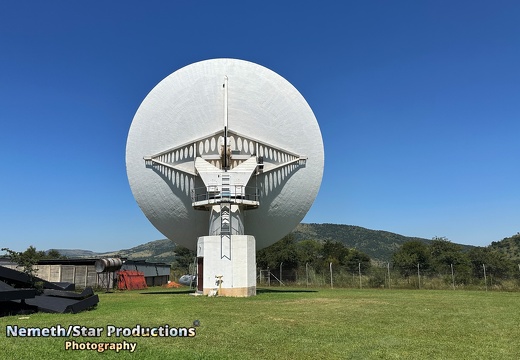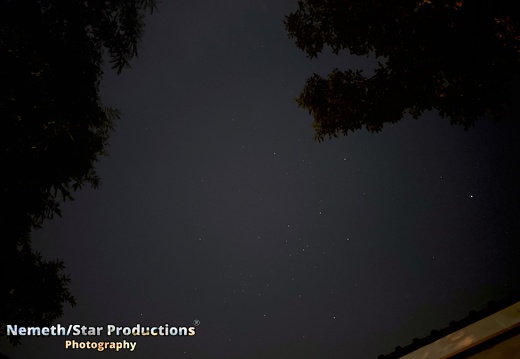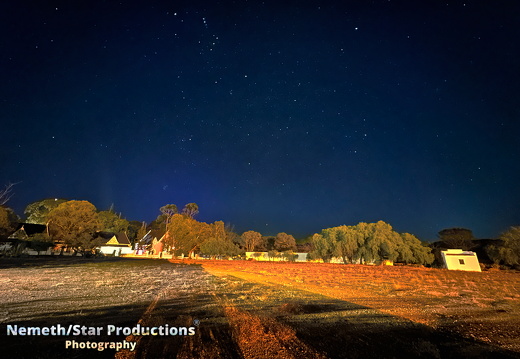
EP01 - HartRAO
Welcome to the first episode of SPACE-FRIDAY: Photography in 2025 and Happy New Year to our audience. Today we take you to a journey to the Hartebeesthoek Radio Astronomy Observatory, short HartRAO, in the valley of the Magaliesberg hills, 75 kilometers north-west of Johannesburg in South Africa.
The HartRAO is one site of space operations of the SARAO, the The South African Radio Astronomy Observatory. The HartRAO was originally established by NASA as Deep Space Station 51 to get data from, and send commands to several unmanned US space missions such as Ranger, Surveyor and Lunar Orbiter spacecrafts, which landed on the Moon or mapped it from orbit, the Mariner missions, which explored the planets Venus and Mars, and the Pioneers, which measured the Sun’s wind.
The HartRAO homes an 85-foot (26- m) diameter antenna, a 15-m radio telescope (called the eXperimental Demonstrator Model) and a new 13.2-m VLBI Global Observing System (VGOS) antenna stands ready for action and will join the geodetic VLBI endeavors once equipped with the requisite receiver. NASA and Roskosmos also home control stations at the HartRAO.
In 1975, the station was handed over to the South African Council for Scientific and Industrial Research (CSIR), which converted it to a radio astronomy observatory. The 26-m radio telescope at HartRAO has played a key role in the development of VLBI in the Southern Hemisphere and has participated in astrometric VLBI observations since the 1980s. Astrometry involves the precise measurements of the positions and movements of celestial objects. Extragalactic source positions are measured in the radio domain using networks of radio telescopes spread throughout the planet and operating jointly in interferometric mode. This so-called VLBI technique has allowed scientists to synchronise antennas across continents into a super telescope the size of the earth to measure the angular direction of compact AGNs with a part per billion accuracy (~100 µas), about the angular size of a 2-Rand (or 1-Euro) coin placed in Australia as seen from South Africa. The HartRAO 26-m radio telescope has been participating in roughly monthly, 24-hour K-band CRF observing sessions over the past seven years, in conjunction with other overseas telescopes in the array, including the Hobart and Mopra telescopes in Australia, the Yebes telescope in Spain, the Korean VLBI Network (KVN) of telescopes, and the Very Long Baseline Array (VLBA) of telescopes in the USA (see figure to the left). Because of its unique geographical location and being part of the only long southern baseline, which is essential for measuring celestial latitude, the 26-m telescope has been a crucial component of the K-band CRF.
One of the ongoing technical developments is the VLBI observing mode for MeerKAT, in collaboration with JIVE (Joint Institute for VLBI ERIC) in the Netherlands and a group of local and international stakeholders. Recently, so-called “fringes” were successfully recorded in joint experiments with telescopes in Europe and at HartRAO.
In 1988, the observatory became a national facility operated by the Foundation for Research Development (FRD), which became part of the NRF in 1999. Initially, the function of HartRAO was purely research in radio astronomy, but in the 1980s a new application called Space Geodesy (geodesy using space techniques) was implemented at HartRAO.
SARAO was established in 2017 by the Minister of Science and Technology as a national facility within the NRF as the institutional successor to the SKA SA Telescope Project and to continue the work of HartRAO. The SKA Project South Africa and the HartRAO are now organized under one unit and the site is officially called “The Hartebeesthoek Site of NRF|SARAO".
Text: Nemeth/Star Productions and SARAO 20th Anniversary report
Thank you very much to the HartRAO, SARAO and NRF for making our visit possible.
All pictures licensed: CC-BY 4.0
Please credit as follows
Photo: Sven Nemeth
Published by: Nemeth/Star Productions (https://nemethstarproductions.eu)

EP02 - Stargazing Buccleuch 2024
We have returned to Buccleuch, in northern Johannesburg for another stargazing night with other constellations.
Tonight we can see the constellations and stars: Pyxis, Pictor, Carina (Carina Nebula, Canopus, Miaplacidus, Avior), Centaurus (Muhlifain), Columba, Crater, Crux (Southern Cross) (Gacrux), Alwazn, Dorado, Canis Major (Adhara, Wezen. Mirzam), Canis Minor (Procyon), Hydra, Antlia, Volans, Puppis (Naos), Vela (Suhel, Regor, Suhail al Muhlif, Alsephina), Orion (Rigel, Tabit), Gemini, Taurus, Eridanus (Al Taj II)
*This episode was also possible thanks to equipment we got on Amazon. Get yours on Amazon:
(ATUMTEK 51" Stand) https://amzn.to/3ZzhYNg
(iPhonePro): https://amzn.to/3ZkDiYD
(Telescope): https://amzn.to/4crNSB8
As in our other documentary productions we count on the technology of the iPhone and this is how the iPhone 14Pro / iPhone Xs makes astrophotography. We use the following apps to support our astrophotography: iPhone NightMode, Stellarium, NightSky, Astrometry Net and NightCap.

EP03 - Stargazing Matjiesfontein
The deep night of the Karoo Desert has taken us in Matjiesfontein, where we find ourselves in a place of stark and enigmatic beauty. Located around 250 kilometres north-west of Cape Town, this area boasts some of the most incredible night skies, with minimal light pollution. This episode, which was produced in February 2024, is the crossover episode with Orbit Mzansi: Photography episode Season 2024-EP04 - Train station. In this episode, we're going to take a look at both the dark night sky and the landscape with night sky photos. There's also one with a special lens effect (no, you won't see any aliens or the devil).
Tonight we see the following star signs and stars in Matjiesfontein.
- Carina (The Keel) with Canopus Suhel (α Car), Miaplacidus (β Car), Avior (ε Car), Aspidiske (ι Car / Turais), Scutulum (ι Car)
- Crux (The Southern Cross) with Acrux (α1 Cru, α2 Cru) and Gacrux (γ Cru)
- Centaurus with Alnair, Cen,
- Vela (The Sails) with Alsephina (δ Vel), Suhail (γ Vel / γ2 Vel), Al Suhail al Wazn (λ Vel)
- Puppis with Naos (ζ Pup), Suhail Hadar (ζ Pup), Regor (γ2 Pup)
- Triangulum Australe with Atria, TrA
- Taurus (Tauri) with Aldebaran
- Orion (shoulder of the hunter) with Beteigeuz,
- Cetus with Diphda, Dheneb, Al Naymat I, Baten Kaitos, Sadr al Kaitos I, Sadr al Kaitos IV
- Phoenix with Alrial V
- Hydra with Alphard, Minazal V, Ukdah II
- Canis Minor with Gomeisa, Procyon
- Ari with Hamal, Sheratan, Bharani, Gorgonea Tertia, Gorgonea Quarta
- Capella with Sirius, Pullox, Rigel
- Bellatrix
- Leo with Regulus
- Volans
- Other Objects: Gem Cluster, Pleiades, NGC 292 (Small Magellanic Cloud), NGC 3372 (Carina Nebula eta Car Nebula).
All pictures licensed: CC-BY 4.0 Please credit as follows Photo: Sven Nemeth Published by: Nemeth/Star Productions (https://nemethstarproductions.eu)








